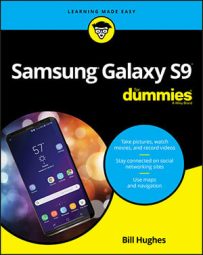- The Power button: The Power button is on the top-right side of the phone. Press it for a few seconds, and the screen lights up. Press it for a second while the phone is on and the phone goes into sleep mode. To shut down the phone completely, simply press and hold the Power button for a few seconds. Then choose the Power Off option from the menu.
- The Volume button(s): Two Volume buttons location on the top-left side of the phone: one to increase the volume, and the other to lower it.
- The touchscreen: The Galaxy S9 phone offers one of the highest-resolution touchscreens, the Super AMOLED, on the market. It’s sensitive enough to allow you to move the screen carefully, but not so sensitive that it’s hard to manage.
- Extended Home screen: This is the first screen that you see. You actually have multiple screens. The extended Home screen is where you can organize icons and other functions to make the phone convenient for you. You’ll find your extended Home screen has some apps already preloaded for you by Samsung and your cellular carrier. Here’s what you’ll find on your Home screen:
- Notification area: The notification area is located at the top of the phone and presents you with small icons that let you know if something important is up, like battery life.
- Primary shortcuts: These five icons at the bottom of the screen remain stationary as you move across the seven Home screens. Samsung and your cellular carrier have determined that these are the most important applications on your phone.
- Device Function keys: These keys (Recent Apps, Home, and Back) reside on the bottom of the phone and control essential phone functions, regardless of what else you have going on at the moment.
- Keyboard: All Galaxy S phones come with a software keyboard. It pops up onscreen when you need to enter text. Otherwise, it goes away to give you the maximum amount of useful screen real estate.

